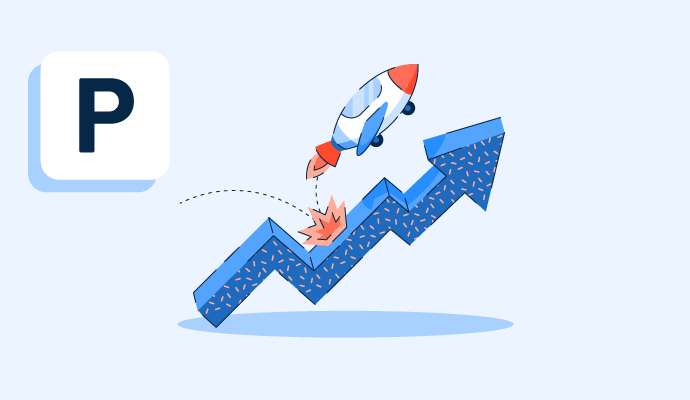What is product-led growth?
Product-led growth (PLG) is a business strategy for driving acquisition, activation, and retention through a software product’s success. The goal of the product is to deliver so much value that users become loyal customers and brand advocates.
Instead of relying on traditional sales and marketing approaches, companies with a product-led growth strategy often hook prospects with free trials and an excellent customer experience. Users see the product as enjoyable, easy, and useful and upgrade to a paid version. This user-centric strategy helps companies increase conversions and scale efficiently.
Companies that favor PLG often rely on digital adoption platforms (DAP) to facilitate their work. A DAP is a software layer that integrates with an application to guide users through onboarding tasks and simplifies the user experience.
Benefits of product-led growth
Product-led growth strategies are on the rise, and companies gravitate to PLG because of benefits like:
- Improved customer satisfaction. PLG organizations design their products to delight users, and they prioritize user experience and customer support. This leads to higher customer satisfaction levels.
- Increased customer lifetime value (CLV). Satisfied customers stick around, improving customer retention rates. This also drives up customer lifetime value, the amount of money a single customer generates throughout their relationship with a company.
- Lower customer acquisition costs (CAC). By increasing the amount the company earns from current customers, PLG reduces its reliance on expensive marketing campaigns. In turn, this lowers customer acquisition costs, the average amount of money the company spends to gain a new customer.
- Increased word-of-mouth marketing (WOM). Happy customers spread the word to family members, friends, and online acquaintances. This leads to new prospects for the company and drives further growth.
- Continuous product improvement. PLG encourages an iterative approach to product development, meaning that companies test and improve their products based on user feedback. As a result, the product improves, giving the company a competitive advantage in the marketplace.
Product-led growth best practices
Despite its many benefits, product-led growth also has some challenges. Companies must build a product that sells itself and grasps customer behavior to encourage retention. Some best practices that help increase success with this strategy include:
- Focus on customer feedback. PLG is a user-centric approach. Companies need to collect customer input to improve the product. To gauge customer satisfaction, they can interview users or launch surveys like net promoter score (NPS)).
- Facilitate virality. Companies should build features into their product that make it easy to turn customers into product advocates. For example, they could add an easy-share option so users can easily invite others within their organization. Or, they could create referral programs with incentives to encourage users to invite external users.
- Provide excellent support. People like to have options when they need help. Some may prefer self-serve resources, like frequently asked questions (FAQ) and video tutorials. Others may prefer getting assistance from agents via a phone line or chat. Customers who get prompt answers to their questions feel more satisfied and get the most out of the product.
- Optimize onboarding. By designing an intuitive onboarding process, companies can increase product adoption rates and help users experience value sooner. The goal is to minimize friction as customers start using the product. Organizations may create a virtual product walkthrough and add a progress bar to the onboarding checklist.
- Test and analyze. PLG requires a data-driven mindset. Companies review data in their analytics platform, looking for places to improve the product. With a hypothesis in mind, developers use A/B testing software to split-test two product versions, testing a current page against a new version.
Product-led growth vs. marketing-led growth vs. sales-led growth
While PLG strategies have exploded in recent years, many software companies still gravitate to more traditional approaches, like marketing-led and sales-led growth. All three strategies have benefits and drawbacks.
- Product-led growth attracts new customers through the irresistibility of its product, which inspires customer loyalty and referrals. With this strategy, companies need exceptional, ever-improving products to achieve success, but they also enjoy organic and sustainable growth and high user satisfaction.
- Marketing-led growth focuses on generating demand and acquiring customers through marketing efforts, like content production and distribution, online advertising, or email campaigns. While these tactics increase CAC, they generate awareness and improve a company’s reach.
- Sales-led growth leans on the sales team to drive revenue and customer acquisition. Salespeople lead prospects through the funnel until they close deals. Sales-led growth lags behind the other two approaches in scalability but allows for a proactive, personalized approach to targeting individual customers.
Learn more about word-of-mouth marketing and how to apply it to your product or service.

Kelly Fiorini
Kelly Fiorini is a freelance writer for G2. After ten years as a teacher, Kelly now creates content for mostly B2B SaaS clients. In her free time, she’s usually reading, spilling coffee, walking her dogs, and trying to keep her plants alive. Kelly received her Bachelor of Arts in English from the University of Notre Dame and her Master of Arts in Teaching from the University of Louisville.

